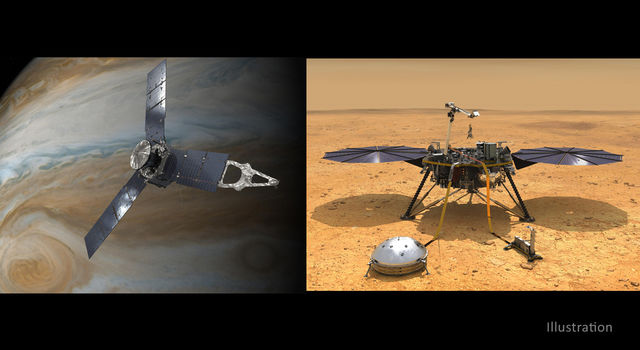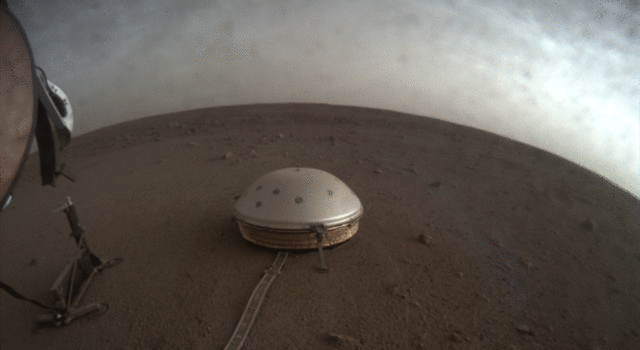Blogs | Dawn Journal | September 27, 2013
NASA's Dawn Spacecraft Celebrates Six Years in Space
Dear Dawnniversaries,
On the sixth anniversary of leaving Earth to embark on a daring deep-space expedition, Dawn is very, very far from its erstwhile planetary residence. Now humankind's only permanent resident of the main asteroid belt between Mars and Jupiter, the seasoned explorer is making good progress toward the largest object in that part of the solar system, the mysterious dwarf planet Ceres. The voyage is long, and the intrepid but patient traveler will not reach its next destination until half a year after its seventh anniversary of departing Earth.
On its fifth anniversary, Dawn was still relatively close to Vesta, the giant protoplanet that had so recently held the craft in its gravitational grip. The only probe ever to orbit a main belt asteroid, Dawn spent 14 months (including its fourth anniversary) accompanying Vesta on its way around the sun. After more than two centuries of appearing to astronomers as little more than a fuzzy blob of light among the stars, the second most massive body in the asteroid belt has been revealed as a fascinating, complex, alien world more closely related to terrestrial planets (including Earth) than to typical asteroids.
Most of the ship's first four years of spaceflight were devoted to using its ion propulsion system to spiral away from the sun, ascending the solar system hill from Earth to Vesta. Now it is working to climb still higher up that hill to Ceres.
For those who would like to track the probe's progress in the same terms used on previous (and, we boldly predict, subsequent) anniversaries, we present here the sixth annual summary, reusing the text from last year with updates where appropriate. Readers who wish to cogitate about the extraordinary nature of this deep-space expedition may find it helpful to compare this material with the logs from its first, second, third, fourth, and fifth anniversaries.
In its six years of interplanetary travels, the spacecraft has thrust for a total of 1,410 days, or 64 percent of the time (and about 0.000000028 percent of the time since the Big Bang). While for most spacecraft, firing a thruster to change course is a special event, it is Dawn's wont. All this thrusting has cost the craft only 318 kilograms (701 pounds) of its supply of xenon propellant, which was 425 kilograms (937 pounds) on September 27, 2007.
The thrusting so far in the mission has achieved the equivalent of accelerating the probe by 8.7 kilometers per second (19,500 mph). As previous logs have described (see here for one of the more extensive discussions), because of the principles of motion for orbital flight, whether around the sun or any other gravitating body, Dawn is not actually traveling this much faster than when it launched. But the effective change in speed remains a useful measure of the effect of any spacecraft's propulsive work. Having accomplished about three-quarters of the thrust time planned for its entire mission, Dawn has already far exceeded the velocity change achieved by any other spacecraft under its own power. (For a comparison with probes that enter orbit around Mars, refer to this earlier log.)
Since launch, our readers who have remained on or near Earth have completed six revolutions around the sun, covering about 37.7 AU (5.6 billion kilometers or 3.5 billion miles). Orbiting farther from the sun, and thus moving at a more leisurely pace, Dawn has traveled 27.4 AU (4.1 billion kilometers or 2.5 billion miles). As it climbed away from the sun to match its orbit to that of Vesta, it continued to slow down to Vesta's speed. It will have to slow down still more to rendezvous with Ceres. Since Dawn's launch, Vesta has traveled only 24.2 AU (3.6 billion kilometers or 2.2 billion miles), and the even more sedate Ceres has gone 22.8 AU (3.4 billion kilometers or 2.1 billion miles).
Another way to investigate the progress of the mission is to chart how Dawn’s orbit around the sun has changed. This discussion will culminate with a few more numbers than we usually include, and readers who prefer not to indulge may skip this material, leaving that much more for the grateful Numerivores. In order to make the table below comprehensible (and to fulfill our commitment of environmental responsibility), we recycle some more text here on the nature of orbits.
Orbits are ellipses (like flattened circles, or ovals in which the ends are of equal size). So as members of the solar system family follow their paths around the sun, they sometimes move closer and sometimes move farther from it.
In addition to orbits being characterized by shape, or equivalently by the amount of flattening (that is, the deviation from being a perfect circle), and by size, they may be described in part by how they are oriented in space. Using the bias of terrestrial astronomers, the plane of Earth's orbit around the sun (known as the ecliptic) is a good reference. Other planets and interplanetary spacecraft may travel in orbits that are tipped at some angle to that. The angle between the ecliptic and the plane of another body's orbit around the sun is the inclination of that orbit. Vesta and Ceres do not orbit the sun in the same plane that Earth does, and Dawn must match its orbit to that of its targets. (The major planets orbit closer to the ecliptic, and part of the arduousness of the journey is changing the inclination of its orbit, an energetically expensive task.)
Now we can see how Dawn has been doing by considering the size and shape (together expressed by the minimum and maximum distances from the sun) and inclination of its orbit on each of its anniversaries. (Experts readily recognize that there is more to describing an orbit than these parameters. Our policy remains that we link to the experts' websites when their readership extends to one more elliptical galaxy than ours does.)
The table below shows what the orbit would have been if the spacecraft had terminated thrusting on its anniversaries; the orbits of its destinations, Vesta and Ceres, are included for comparison. Of course, when Dawn was on the launch pad on September 27, 2007, its orbit around the sun was exactly Earth's orbit. After launch, it was in its own solar orbit.
| Minimum distance from the Sun (AU) | Maximum distance from the Sun (AU) | Inclination | |
|---|---|---|---|
| Earth's orbit | 0.98 | 1.02 | 0.0° |
| Dawn's orbit on Sept. 27, 2007 (before launch) | 0.98 | 1.02 | 0.0° |
| Dawn's orbit on Sept. 27, 2007 (after launch) | 1.00 | 1.62 | 0.6° |
| Dawn's orbit on Sept. 27, 2008 | 1.21 | 1.68 | 1.4° |
| Dawn's orbit on Sept. 27, 2009 | 1.42 | 1.87 | 6.2° |
| Dawn's orbit on Sept. 27, 2010 | 1.89 | 2.13 | 6.8° |
| Dawn's orbit on Sept. 27, 2011 | 2.15 | 2.57 | 7.1° |
| Vesta's orbit | 2.15 | 2.57 | 7.1° |
| Dawn's orbit on Sept. 27, 2012 | 2.17 | 2.57 | 7.3° |
| Dawn's orbit on Sept. 27, 2013 | 2.44 | 2.98 | 8.7° |
| Ceres's orbit | 2.56 | 2.98 | 10.6° |
For readers who are not overwhelmed by the number of numbers, investing the effort in studying the table may help to demonstrate how Dawn has patiently transformed its orbit during the course of its mission. Note that two years ago, the spacecraft's path around the sun was exactly the same as Vesta's. Achieving that perfect match was, of course, the objective of the long flight that started in the same solar orbit as Earth, and that is how Dawn managed to slip into orbit around Vesta. While simply flying by it would have been far easier, matching orbits with Vesta required the extraordinary capability of the ion propulsion system. Without that technology, NASA's Discovery Program would not have been able to afford a mission to explore it in such detail. But now, Dawn has gone even beyond that. Having discovered so many of Vesta's secrets, the stalwart adventurer left the protoplanet behind. No other spacecraft has ever escaped from orbit around one distant solar system object to travel to and orbit still another extraterrestrial destination. A true interplanetary spaceship, Dawn is enlarging, reshaping and tilting its orbit again so that in 2015, it will be identical to Ceres's. A mission to both Vesta and Ceres would have been impossible without ion propulsion.
One way to chart Dawn's progress is with numbers. Another is to look inside ourselves and feel the awe at an extraordinary enterprise undertaken on our behalf. This robotic emissary from Earth to the cosmos has journeyed far, swooping by Mars even as its sights were set on distant, uncharted lands beyond. Powering its way through the solar system with a blue-green beam of xenon ions, the ambitious explorer is introducing humankind to ancient worlds, giant remnants from the dawn of the solar system. With each passing year, we travel farther and see more thanks to Dawn. It is amazing that creatures humble yet bold, who are physically confined to the vicinity of their planet, not only take on such daunting challenges but actually succeed in reaching so far and attaining so much. As Dawn begins the seventh year of its interplanetary odyssey, we can marvel at all that it has accomplished so far and look forward with eager anticipation to more rewards that lie ahead: new knowledge, new insights, new perspectives, and new fuel for those who feel the burning passion to venture still farther.
Dawn is 23 million kilometers (14 million miles) from Vesta and 44 million kilometers (27 million miles) from Ceres. It is also 3.32 AU (496 million kilometers or 308 million miles) from Earth, or 1,230 times as far as the moon and 3.31 times as far as the sun today. Radio signals, traveling at the universal limit of the speed of light, take 55 minutes to make the round trip.
Dr. Marc D. Rayman
4:34 a.m. PDT September 27, 2013
TAGS:DAWN, CERES, VESTA, DWARF PLANETS, SOLAR SYSTEM, MISSION, SPACECRAFT







